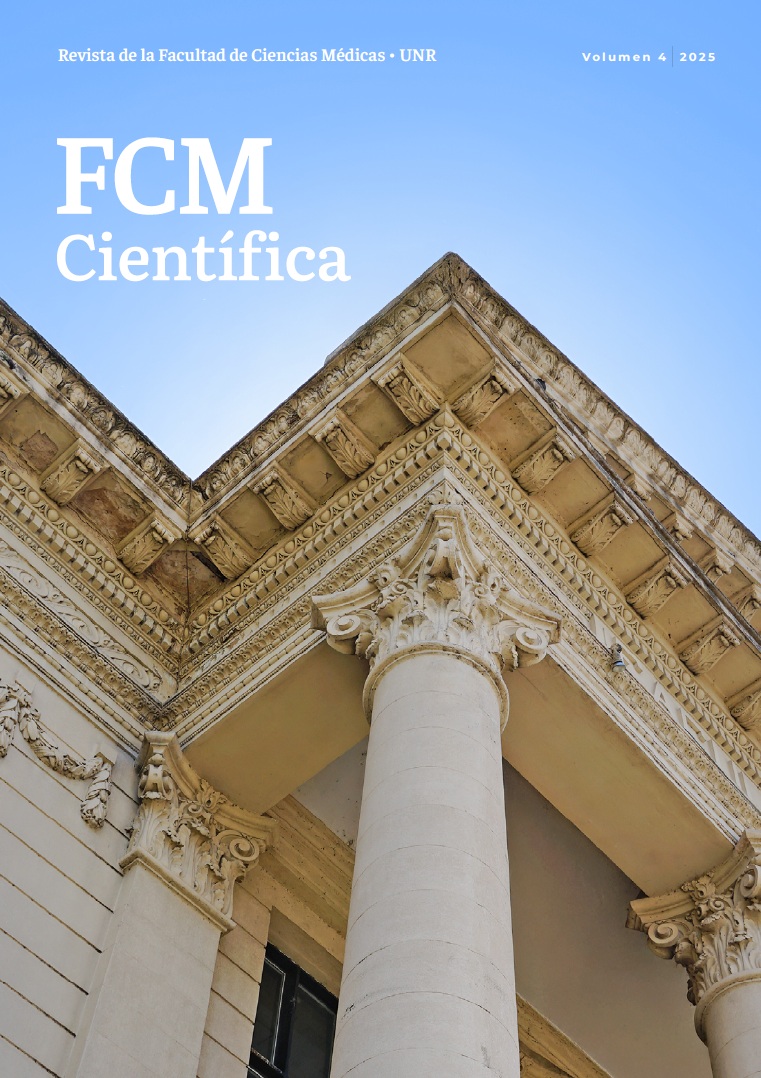“STUDY OF THE VASODILATORY EFFECT OF PROANTHOCYANIDINS EXTRACTED FROM LIGARIA CUNEIFOLIA (PLc)”
“PROANTHOCYANIDINS EXTRACTED FROM LIGARIA CUNEIFOLIA (PLc)”
DOI:
https://doi.org/10.35305/fcm.v4i.114Keywords:
Ligaria Cuneifolia; Proanthocyanidins; Hypotensive; Vasodilatation; HypotensorAbstract
Introduction: The infusion of the crude extract Ligaria cuneifolia (Lc host Chañar), is used in folk medicine for its supposed antihypertensive action (1,2,3).
Objective: To investigate the potential vasoactive effect of proanthocyanidin-enriched extract extracted from Lc (PLc) on isolated rats aortic rings (4,5).
Materials and Methods: aorta rings were placed in a 20 mL chamber with modified Krebs-Henseleit solution (KHM) balancing out for 60 min. Isometric vessel tension was measured with a force displacement transducer connected to a polygraph. Subsequently, the rings were contracted with 70 mM K+, repeating the procedure until a stable maximal contraction was achieved; post-stabilization for 10 min, vessels were contracted with phenylephrine (0.1µM) and, upon reaching a stable maximum contraction, PLc was added at increasing concentrations (7.14 x 10-6; 7.14 x 10-5; 7.14 x 10-4; 7.14 x 10-3; 7.14 x 10-2; 7.14 x 10-1; and 71.4 µg/mL) so as to create a concentration-response curve. Then, the vessels were again contracted with K+ and finally contracted with for the acetylcholine test (ACh; 1 µM).
Results: The concentration of PLc that induced maximal relaxation was 71.4 µg/mL. The PLc concentration producing 50% relaxation of 6.86 µg/mL (n=4) was estimated using a 4-parameter logistic equation (R2 = 0.92).
Discussion: PLc has an endothelium-dependent vasodilator effect, the mechanical removal of the endothelium abolishes the relaxant activity of PLc. It reached a magnitude equivalent to the maximal ACh-induced response of about 80% of basal tension.
Conclusion: Results support the popular use of Lc. as a hypotensive.
Acknowledgment: Rosario National University
Downloads
References
1. Abbiatti D. Las Lorantáceas Argentinas. Rev Mus La Plata (N. S.), Sec Bot. 1946; 7:1-110.
2. G. Scarpa, M. Montani, ‘Etnobotánica médica de las ‘ligas’ (Loranthaceae sensu lato) entre indígenas y criollos de Argentina’, Dominguezia 2011;27, 5-19.
3. C. Dobrecky, S. Lucangioli, M.Wagner. The Argentine Mistletoes Ligaria cuneifolia (Ruiz & Pav.) Tiegh (Loranthaceae) and Phoradendron liga (Gillies ex Hook. & Arn.) Eichler (Santalaceae): Thirty Years of Research; Wiley VCH Verlag; Chemistry and Biodiversity; 19; 10; 9-2022; 1-20: e202200565, http://dx.doi.org/10.1002/cbdv.202200565
4. T. Fernández , M. Wagner, B. G. Varela, R. A. Ricco , S. E. Hajos et al. Estudio de un muérdago argentino, el hemiparásito Ligaria cuneifolia (R. et P.) Tiegh.(Loranthaceae). J Ethnopharmacol. 1998;62(1):25-34,
5. G.Mengarelli, A. Dominighini, M. Ferrero, et al. Evaluation of hemorheologic parameters and biliary secretion in Ligaria cuneifolia (Argentine mistltoe) extracted treated rats. Pharm Biol. 2001;39(6): 435-439.
6. A. Dominighini, M. Ferrero, G. Mengarelli et al. Hemorrheologic changes induced by aqueous extract of Ligaria cuneifolia: Treatment bytwo different administration routes.Clinical Hemorheology and Microcirculation. 2004; 31(2):113-21.
7. M. Ferrero, D. Crosetti, A. Dominighini, ‘Effect of the vehicle polyvinylpyrrolidone and the Methanolic Fraction of Ligaria cuneifolia (Argentine Mistletoe) extract on hemorheological properties and biliary secretion in rats. Clin. Hemorheol. Microcirc. 2007; 36: 95–104.
8. A. Dominighini, M. Ferrero, M. Wagner et al. Effect of Ligaria cuneifolia catechin- and quercetin- enriched fractions on hemorheology and plasma cholesterol. Clin Hemorheol Microcirc. 2010; 44: 1-9.
9. D. Crosetti, M. Ferrero, A. Dominighini, et al. Efecto in vitro de proantocianidina extraída de Ligaria cuneifolia (Lc) sobre la deformabilidad, resistencia osmótica y forma eritrocitaria. Medicina 2006;66(2):26
10. A. Dominighini, M. Ferrero, D. Crosetti, et al. Effects of proanthocyanidin enriched extract from Ligaria cuneifolia on plasma cholesterol and hemorheological parameters.In vivo and In vitro studies. Clin Hemorheol Microcirc. 2015; 60: 317–325.
11. A. Dominighini, M. Ferrero, D. Crosetti, et al. Efecto de prantocianidinas extraídas de Ligaria cuneifolia sobre la concentración de colesterol plasmático y su excreción biliar Medicina 66(2):155, 2006
12. J. Izquierdo, S. Starita. Acciones vasculares dei Phrygilanthus flagellaris y dei Psittacanthus cuneifolius . Rev. Farm. 1955; 97: 177-81
13. S. Vásquez y Novo, M. Wagner, A. Gumi et al. Importancia Toxicológica de la presencia de sustancias aminadas en ejemplares de Ligaria cuneifolia var. cuneifolia colectados en diferentes áreas de la República Argentina. Acta Farm. Bonaerense.1989; 8: 23-9
14. C. Taira, M. Wagner, H. Adrado, R. Pino, A. Gurni. “Estudio Farmacológico de un Agente Vasoactivo presente en Ligaria cuneifolia var. cuneifolia”. Acta Farmacéutica Bonaerense. 1994; 13 (2): 91-95.
15. National Research Council (US) Committee for the Update of the Guide for the Careand Use of Laboratory Animals. Guide for the Care and Use of Laboratory Animals, 8th ed. Washington (DC) National Academies Press, 2011.
16. R. Vinet, C. Brieva, G. Pinardi, M. Penna, Modulation of alpha-adrenergic-induced contractions by endothelium-derived relaxing factor in rat aorta. Gen. Pharmacol. Vasc. Syst. 1991, 22, 137-142.
17. S. Guimaraes, D. Moura. Vascular adrenoceptors: an update. Pharmacol Rev. 2001; 53: 319-356.
18. M. Spinella. The importance of pharmacological synergy in psychoactive herbal medicines. Altern Med Rev. 2002; 7: 130-137.
19. T. Matsubara, T. Bohgaki, M. Watarai, H.Suzuki, K. Ohashiy H.Shibuya. Antihypertensive actions of methylripariochromene A from Orthosiphon aristatus, an Indonesian traditional medicinal plant. Biol Pharm Bull .1999; 22: 1083-1088.
20. D. Sánchez, B.Somoza, T. Ortega, A. Villar. Isolation of vasodilatory active flavonoids from the traditional remedy Satureja obovata. Planta Med. 1996; 62: 272-274.
21. T. Fernández, M. Wagner, B. Varela, et al. Study of an Argentine mistletoe, the hemiparasite Ligaria cuneifolia (R. et P.) Tiegh (Lorantaceae). J Ethnopharmacol. 1998; 62(1): 25-34.
22. ML Wagner, CB Dobrecky, BG Varela et al. Ligaria cuneifolia (R. et P.) Tiegh. In: Medicinal and Aromatic Plants of South America 2: Argentina, Chile and Uruguay.Editorial: Springer. 2021, p.295-310.
23. M. Ferrero, M. Svetaz, C. Giacosa, et al. Efecto de la infusión de Ligaria cuneifolia o Muérdago criollo sobre el perfil lipídico en pacientes con hipercolesterolemia. Argentine Cardiology J. 2015; 44(1): 25.
Published
How to Cite
Issue
Section
License
Copyright (c) 2025 Revista de la Facultad de Ciencias Médicas. Universidad Nacional de Rosario.

This work is licensed under a Creative Commons Attribution-NonCommercial 4.0 International License.







